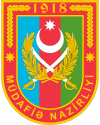United Armed Forces of the Commonwealth of Independent States
You can help expand this article with text translated from the corresponding article in Russian. (May 2022) Click [show] for important translation instructions.
|
| United Armed Forces of the Commonwealth of Independent States | |
|---|---|
| Объединённые Вооружённые силы Содружества Независимых Государств | |
 Emblem of the Soviet Armed Forces | |
| Founded | 14 February 1992 |
| Disbanded | 24 December 1993 |
| Leadership | |
| Commander-in-Chief | Yevgeny Shaposhnikov |
The United Armed Forces of the Commonwealth of Independent States (Russian: Объединённые Вооружённые силы Содружества Независимых Государств) was a short-lived military entity associated with the Commonwealth of Independent States. It was created in 1992 after the demise of the Soviet Union, and was intended to be the continuation of the Soviet Armed Forces and to hold control over the Soviet Union's nuclear weapons.
It was rapidly superseded by the de facto Russian control of those nuclear weapons,[1] and the formation of separate national armies for each of the former Soviet states, and had effectively ceased to exist by the end of 1993.[2][3]
Formation
[edit]The Soviet Union officially dissolved on 25 December 1991. After signing the Belavezha Accords on 21 December 1991, the countries of the newly formed CIS signed a protocol on the temporary appointment of Marshal of Aviation Yevgeny Shaposhnikov as Minister of Defence and commander of the armed forces in their territory, including strategic nuclear forces. On 14 February 1992 Shaposhnikov formally became Supreme Commander of the CIS Armed Forces.
Disintegration
[edit]On 16 March 1992 a decree by Boris Yeltsin created the Armed Forces of the Russian Federation under the operational control of Allied High Command and the Ministry of Defence, which was headed by the President. Finally, on 7 May 1992, Yeltsin signed a decree establishing the Russian armed forces and Yeltsin assumed the duties of the Supreme Commander.[4] In May 1992, General Colonel Pavel Grachev became the Russian Minister of Defence, and was made Russia's first Army General on assuming the post.
After this announcement, Marshal of Aviation Yevgeny Shaposhnikov, Commander-in-Chief of CIS Armed Forces, Head of the Main Command (Glavkomat) "and a skeletal staff to support his role as commander of the CIS Armed Forces were evicted from the MoD and General Staff buildings and given offices in the former Warsaw Pact headquarters on the northern outskirts of Moscow" (on Prospekt Mira).[5] Shaposhnikov's staff quickly became a very weak body as the new states' authorities asserted their control over their own armed forces. On 15 June 1993 Shaposhnikov's staff was abolished, and Shaposhnikov resigned.[6][7] By the end of 1993 the abolition of the Joint Military Command (Glavkomat) had become effective.[7]
The CIS Joint Military Command was replaced with a scaled-down Joint Staff for Coordinating Military Cooperation.[6] An agreement was formally signed at Ashgabat on 24 December 1993 to establish the Staff for the Coordination of Military Cooperation Member States of the Commonwealth of Independent States (Russian: Штабе по координации военного сотрудничества государств – участников Содружества Независимых Государств).[8] Colonel General Viktor Samsonov took up the role until October 1996. Army General Vladimir Yakovlev appears to have become Chief of the Staff in June 2001.[9]
See also
[edit]- Collective Security Treaty Organization
- Collective Rapid Reaction Force
- Joint CIS Air Defense System
References
[edit]- ^ "The Four CIS Republics and the Soviet Nuclear Legacy". Implications of the Start Ii Treaty for Us-Russian Relations: 25–36. 1993.
- ^ Vozzhenikov, A. V.; Alkhlayev, Sh M. (2007-01-01). "The evolution of CIS military-political cooperation". Military Thought. 16 (1): 136–146.
- ^ Odom 1998.
- ^ Министерство обороны Российской Федерации [Ministry of Defence of the Russian Federation] (in Russian). Politika.su. Archived from the original on 21 December 2012. Retrieved 24 March 2014.
- ^ Odom 1998, p. 386-87.
- ^ a b Lynch 1999, p. 76.
- ^ a b McIntosh, p. 121.
- ^ "Идет перенаправление".
- ^ DS2002-0819). See also ru:Объединённые Вооружённые силы Содружества Независимых Государств.
- Lynch, Dov (1999). Russian Peacekeeping Strategies in the CIS: The Case of Moldova, Georgia and Tajikistan. Springer. ISBN 9780333984215.
- McIntosh, Daniel (1994). "Russian Intervention and the Commonwealth of Independent States". Journal of Political Science. 22 (1). ISSN 0098-4612.
- Odom, William E. (1998). The Collapse of the Soviet Military. Yale University Press. ISBN 0-300-07469-7.
External links
[edit]- Commonwealth Defense Arrangements and International Security. Center for Naval Analyses, June 1992
- CSTO, History of Organizational Development and development of the Joint Staff of the Collective Security Treaty Organization
- Dissolution of the Soviet Union
- Military of the Commonwealth of Independent States
- Military history of Armenia
- Military history of Azerbaijan
- Military history of Belarus
- Military history of Kazakhstan
- Military history of Kyrgyzstan
- Military history of Russia
- Military history of Tajikistan
- Military of Turkmenistan
- Military of Uzbekistan
- 1992 establishments in Armenia
- 1992 establishments in Azerbaijan
- 1992 establishments in Belarus
- 1992 establishments in Kazakhstan
- 1992 establishments in Kyrgyzstan
- 1992 establishments in Russia
- 1992 establishments in Tajikistan
- 1992 establishments in Turkmenistan
- 1992 establishments in Uzbekistan
- 1993 disestablishments in Armenia
- 1993 disestablishments in Azerbaijan
- 1993 disestablishments in Belarus
- 1993 disestablishments in Kazakhstan
- 1993 disestablishments in Kyrgyzstan
- 1993 disestablishments in Russia
- 1993 disestablishments in Tajikistan
- 1993 disestablishments in Turkmenistan
- 1993 disestablishments in Uzbekistan
- Military units and formations established in 1992
- Military units and formations disestablished in 1993





